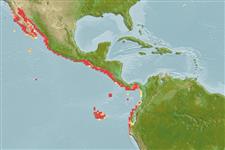Teleostei (teleosts) >
Ophidiiformes (Cusk eels) >
Ophidiidae (Cusk-eels) > Ophidiinae
Etymology: Lepophidium: Latin, lepus, leporis = rabbit + Greek, ophis = serpent (Ref. 45335).
More on authors: Hildebrand & Barton.
Environment: milieu / climate zone / depth range / distribution range
Ecology
Marine; demersal; depth range 40 - 390 m (Ref. 34024). Tropical; 32°N - 7°S, 118°W - 76°W (Ref. 91765)
Eastern Pacific: Gulf of California, outer coast of Baja California, and off northwestern South America.
Size / Weight / Age
Maturity: Lm ? range ? - ? cm
Max length : 52.7 cm SL male/unsexed; (Ref. 91765); common length : 35.0 cm TL male/unsexed; (Ref. 55763)
Dorsal spines (total): 0; Dorsal soft rays (total): 134 - 148; Anal spines: 0; Anal soft rays: 111 - 123; Vertebrae: 75 - 80. This species is characterized by the following: usual number of vertebrae, precaudal 16 (14-17), caudal 60-62 (59-64), total 76-78 (75-80); fin rays, dorsal 138-146 (134-148), anal 117-120 (111-123) pectoral 23-24 (21-25); pyloric caeca 4-5 (3-6), usually 3-4 in one whorl, 1-2 in second tier, sometimes 1 in a third tier; first gill arch with rudimentary rakers 3 (2-4) on the upper arm, 4 (sometimes 5) developed but short rakers on lower arm, rudiments anterior on the first arch vary from 1-10 (usually 5-8); total rakers 12-16 (9-18) with most of the variations due to the rudiments; dorsal-fin origin between neural spines 4-5 (26 specimens) or 3-4 (17 specimens) (Ref. 91765).
Common species (Ref. 34024). Adults inhabit soft bottoms, from shallow waters to moderate depths (Ref. 9329). Oviparous, with planktonic larvae (Ref. 36413). Oval, pelagic eggs float in a gelatinous mass (Ref. 205).
Life cycle and mating behavior
Maturities | Reproduction | Spawnings | Egg(s) | Fecundities | Larvae
Robins, C.R., R.H. Robins and M.E. Brown, 2012. A revision of Lepophidium (Teleoastei, Ophidiidae), with descriptions of eight new species. Bulletin of the Florida Museum of Natural History 52(1):1-94. (Ref. 91765)
IUCN Red List Status (Ref. 130435)
Threat to humans
Harmless
Human uses
Fisheries: of potential interest
Tools
Special reports
Download XML
Internet sources
Estimates based on models
Preferred temperature (Ref.
123201): 11.9 - 16.8, mean 14.4 °C (based on 59 cells).
Phylogenetic diversity index (Ref.
82804): PD
50 = 0.5000 [Uniqueness, from 0.5 = low to 2.0 = high].
Bayesian length-weight: a=0.00234 (0.00101 - 0.00543), b=3.16 (2.98 - 3.34), in cm total length, based on LWR estimates for this Genus-body shape (Ref.
93245).
Trophic level (Ref.
69278): 3.8 ±0.7 se; based on size and trophs of closest relatives
Resilience (Ref.
120179): Medium, minimum population doubling time 1.4 - 4.4 years (Preliminary K or Fecundity.).
Fishing Vulnerability (Ref.
59153): Moderate to high vulnerability (46 of 100).
